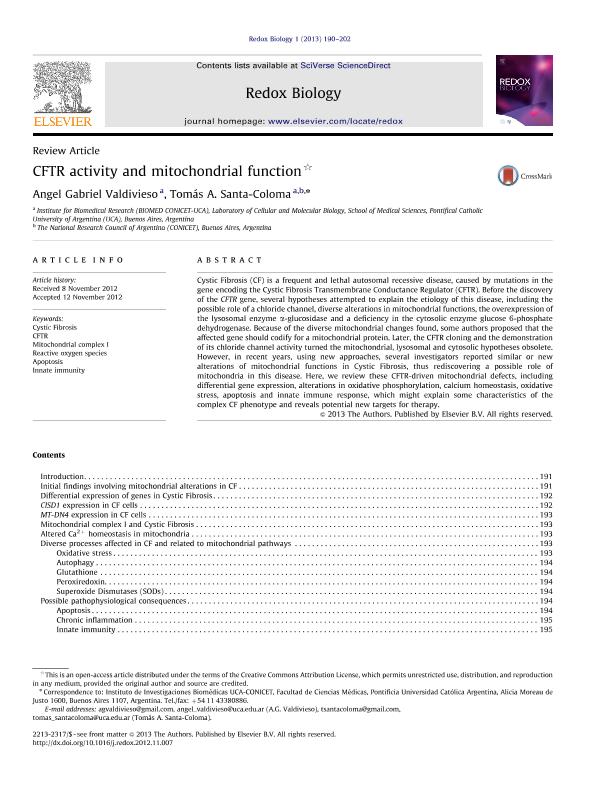Mostrar el registro sencillo del ítem
dc.contributor.author
Valdivieso, Ángel Gabriel

dc.contributor.author
Santa Coloma, Tomás Antonio

dc.date.available
2017-07-18T21:12:36Z
dc.date.issued
2013-01
dc.identifier.citation
Valdivieso, Ángel Gabriel; Santa Coloma, Tomás Antonio; CFTR activity and mitochondrial function; Elsevier Science; Redox Biology; 1; 1; 1-2013; 190-202
dc.identifier.issn
2213-2317
dc.identifier.uri
http://hdl.handle.net/11336/20884
dc.description.abstract
Cystic Fibrosis (CF) is a frequent and lethal autosomal recessive disease, caused by mutations in the gene encoding the Cystic Fibrosis Transmembrane Conductance Regulator (CFTR). Before the discovery of the CFTR gene, several hypotheses attempted to explain the etiology of this disease, including the possible role of a chloride channel, diverse alterations in mitochondrial functions, the overexpression of the lysosomal enzyme α-glucosidase and a deficiency in the cytosolic enzyme glucose 6-phosphate dehydrogenase. Because of the diverse mitochondrial changes found, some authors proposed that the affected gene should codify for a mitochondrial protein. Later, the CFTR cloning and the demonstration of its chloride channel activity turned the mitochondrial, lysosomal and cytosolic hypotheses obsolete. However, in recent years, using new approaches, several investigators reported similar or new alterations of mitochondrial functions in Cystic Fibrosis, thus rediscovering a possible role of mitochondria in this disease. Here, we review these CFTR-driven mitochondrial defects, including differential gene expression, alterations in oxidative phosphorylation, calcium homeostasis, oxidative stress, apoptosis and innate immune response, which might explain some characteristics of the complex CF phenotype and reveals potential new targets for therapy.
dc.format
application/pdf
dc.language.iso
eng
dc.publisher
Elsevier Science

dc.rights
info:eu-repo/semantics/openAccess
dc.rights.uri
https://creativecommons.org/licenses/by-nc-nd/2.5/ar/
dc.subject
Cystic Fibrosis
dc.subject
Cftr
dc.subject
Mitochondrial Complex I
dc.subject
Reactive Oxygen Species
dc.subject
Apoptosis
dc.subject
Innate Immunity
dc.subject.classification
Bioquímica y Biología Molecular

dc.subject.classification
Medicina Básica

dc.subject.classification
CIENCIAS MÉDICAS Y DE LA SALUD

dc.title
CFTR activity and mitochondrial function
dc.type
info:eu-repo/semantics/article
dc.type
info:ar-repo/semantics/artículo
dc.type
info:eu-repo/semantics/publishedVersion
dc.date.updated
2017-07-18T20:06:50Z
dc.journal.volume
1
dc.journal.number
1
dc.journal.pagination
190-202
dc.journal.pais
Países Bajos

dc.journal.ciudad
Ámsterdam
dc.description.fil
Fil: Valdivieso, Ángel Gabriel. Pontificia Universidad Católica Argentina "Santa María de los Buenos Aires". Instituto de Investigaciones Biomédicas. Consejo Nacional de Investigaciones Científicas y Técnicas. Oficina de Coordinación Administrativa Houssay. Instituto de Investigaciones Biomédicas; Argentina
dc.description.fil
Fil: Santa Coloma, Tomás Antonio. Pontificia Universidad Católica Argentina "Santa María de los Buenos Aires". Instituto de Investigaciones Biomédicas. Consejo Nacional de Investigaciones Científicas y Técnicas. Oficina de Coordinación Administrativa Houssay. Instituto de Investigaciones Biomédicas; Argentina
dc.journal.title
Redox Biology
dc.relation.alternativeid
info:eu-repo/semantics/altIdentifier/doi/http://www.sciencedirect.com/science/article/pii/S2213231712000092
dc.relation.alternativeid
info:eu-repo/semantics/altIdentifier/doi/http://dx.doi.org/ 10.1016/j.redox.2012.11.007
dc.relation.alternativeid
info:eu-repo/semantics/altIdentifier/url/https://www.ncbi.nlm.nih.gov/pmc/articles/PMC3757715/
Archivos asociados
